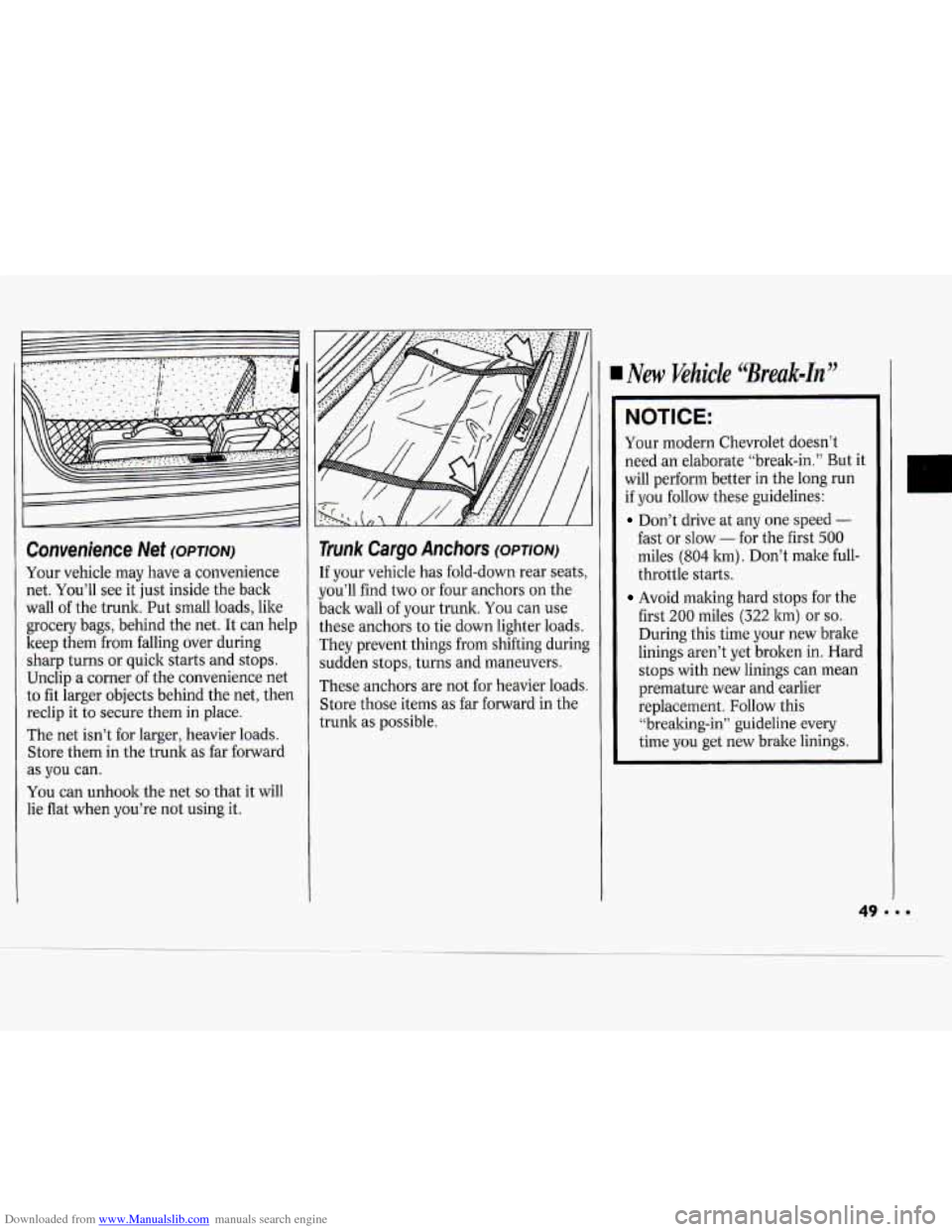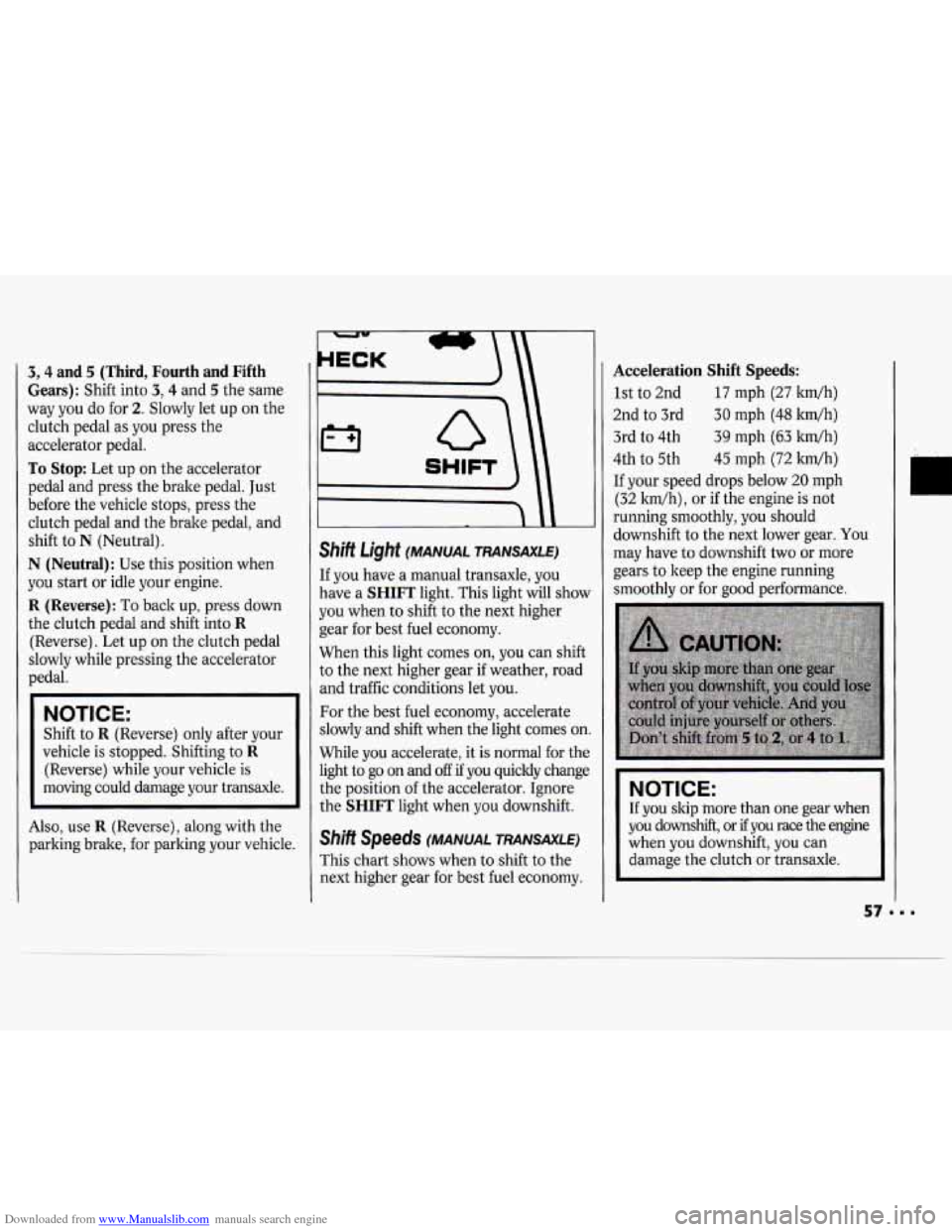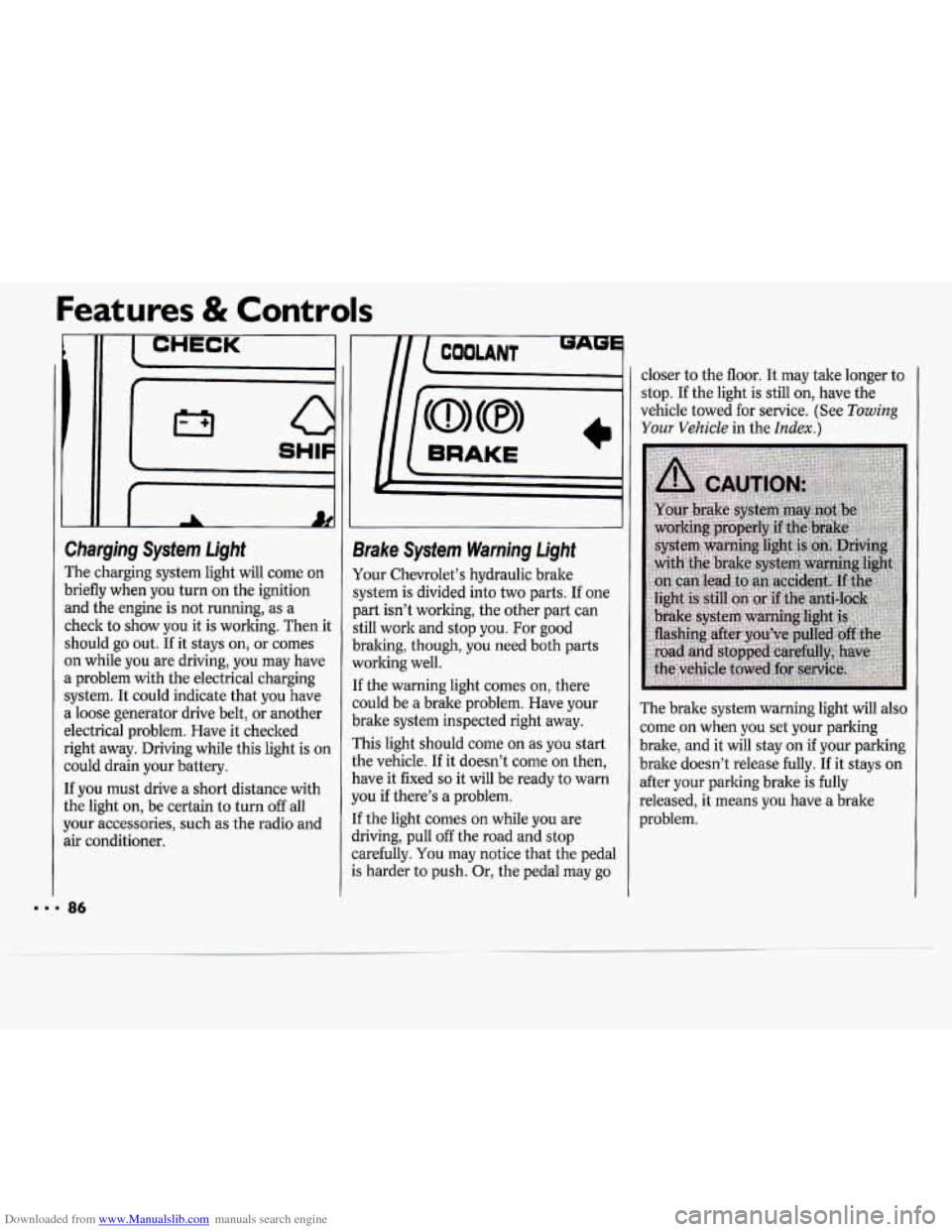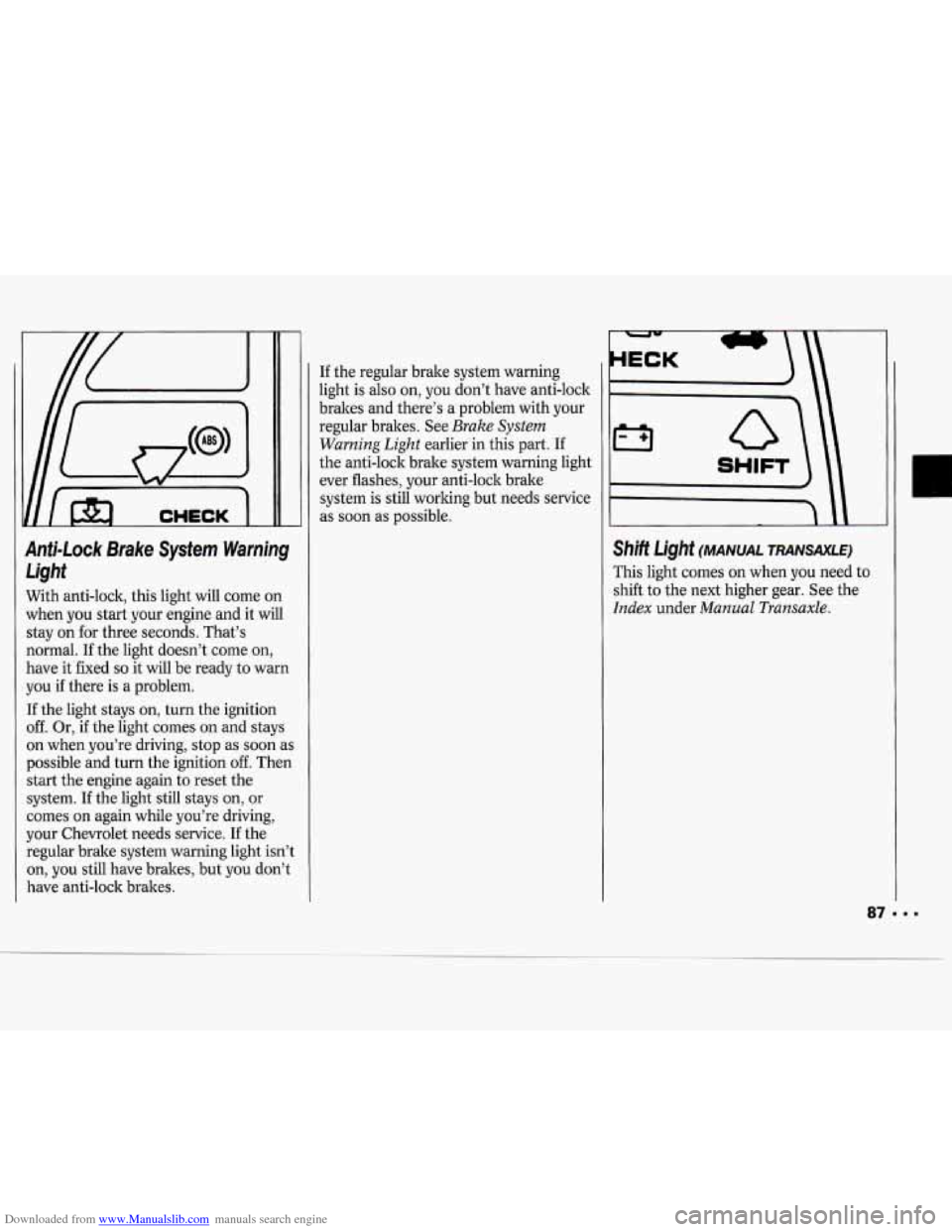1994 CHEVROLET CAVALIER stop start
[x] Cancel search: stop startPage 50 of 243

Downloaded from www.Manualslib.com manuals search engine Convenience Net (OPTION)
Your vehicle may have a convenience
net. You’ll see it just inside the back
wall of the trunk. Put small loads, like
grocery bags, behind the net. It can help
keep them
from falling over during
sharp turns or quick starts and stops.
Unclip a corner of the convenience net
to fit larger objects behind the net, then
reclip it to secure them in place.
The net isn’t for larger, heavier loads.
Store them in the trunk as far forward
as
you can.
You can unhook the net
so that it will
lie flat when you’re not using it.
Trunk Cargo Anchors (OPTION)
If your vehicle has fold-down rear seats,
you’ll find two or four anchors on the
back wall of your trunk.
You can use
these anchors to tie down lighter loads.
They prevent things from shifting during
sudden stops, turns and maneuvers.
These anchors are not for heavier loads.
Store those items as far forward in the
trunk as possible.
New Khicle ‘Break-in"
NOTICE:
Your modern Chevrolet doesn’t
need an elaborate “break-in.” But it
will perform better in the long run
if you follow these guidelines:
Don’t drive at any one speed -
fast or slow - for the fist 500
miles (804 km) . Don’t make full-
throttle starts.
Avoid making hard stops for the
first
200 miles (322 km) or so.
During this time your new brake
linings aren’t yet broken in. Hard
stops with new linings can mean
premature wear and earlier
replacement. Follow this
“brealring-in” guideline every
time you get new brake linings.
Page 52 of 243

Downloaded from www.Manualslib.com manuals search engine Key Release Button
(MANUAL TRANSAXLE)
The ignition key cannot be removed
from the ignition unless the key release
button is used.
To Remove the Key:
Turn the key to the Off position. Press
the key release button while turning the
key from
Off to Lock. Keeping your
finger
on the button, pull the key
straight out.
Starting Your Engine
Follow the proper steps to start the
engine.
Automatic Transaxle:
Move your shift lever to P (Park) or N
(Neutral). Your engine won’t start in
any other position
- that’s a safety
feature.
To restart when you’re already
moving, use
N (Neutral) only.
NOTICE:
Don’t try to shift to P (Park) if your
Chevrolet is moving. If you do, you
could damage the transaxle.
Shift
to P (Park) only when your vehicle
is stopped.
Manual Transaxle:
Hold the clutch pedal to the floor, then
shift your gear selector to
N (Neutral)
while starting the engine. Your vehicle
won’t start if the clutch pedal is not all
the way down
- that’s a safety feature.
To start your engine:
1. Without pushing the accelerator
pedal, turn your ignition key to
Start.
When the engine starts, let go of the
key. The idle speed will go down as
your engine gets warm.
NOTICE:
Holding your key in Start for longer
than
15 seconds at a time will cause
your battery to be drained much
sooner. And the excessive heat can
damage your starter motor.
2. If your engine still won’t start (or
starts but then stops), it could be
flooded with too much gasoline. Try
pushing your accelerator pedal all the
way to the floor and holding it there
as you hold the key in
Start for about
three seconds.
If the vehicle starts
briefly but then stops again, do the
same thing, but this time keep the
pedal down for five or
six seconds.
This clears the extra gasoline from
the engine.
n
Page 55 of 243

Downloaded from www.Manualslib.com manuals search engine Features & Controls
Ensure the shift lever is fully in P
(Park) range before starting the engine.
Your Chevrolet has a brake-transaxle
shift interlock.
You have to fully apply
your regular brakes before you can shift
from
P (Park) when the ignition ley is
in the
Run position. If you cannot shift
out of
P (Park), ease pressure on the
shift lever-push the shift lever all the
way into
P (Park) and also release the
shift lever button as you maintain brake
application. Then move the shift lever
into the gear you
wish. See the Index
under Shifting Out of P (Park).
Reverse
R (Reverse): Use this gear to back up.
NOTICE:
Shifting to R (Reverse) while your
vehicle is moving forward could
damage your transaxle. Shift to
R
only after your vehicle has stopped.
To rock your vehicle back and forth to
get out
of snow, ice or sand without
damaging your transaxle, see the
Index
under If You’re Stuck: In Sand, Mud,
Ice or Snow.
54
Page 58 of 243

Downloaded from www.Manualslib.com manuals search engine 3,4 and 5 (Third, Fourth and Fifth
Gears):
Shift into 3,4 and 5 the same
way you do for
2. Slowly let up on the
clutch pedal as you press the
accelerator pedal.
To Stop: Let up on the accelerator
pedal and press the brake pedal.
Just
before the vehicle stops, press the
clutch pedal and the brake pedal, and
shift to
N (Neutral).
N (Neutral): Use this position when
you start or idle your engine.
R (Reverse): To back up, press down
the clutch pedal and shift into
R
(Reverse). Let up on the clutch pedal
slowly while pressing the accelerator
pedal.
NOTICE:
Shift to R (Reverse) only after your
vehicle is stopped. Shifting to
R
(Reverse) while your vehicle is
moving could damage your transaxle.
Also, use R (Reverse), along with the
parking brake, for parking your vehicle.
SHIFT
Shift Light (MANUAL TRANSAXLE)
If you have a manual transaxle, you
have a
SHIFT light. This light will show
you when to shift to the next higher
gear for best fuel economy.
When this light comes on, you can shift
to the next higher gear
if weather, road
and traffic conditions let you.
For the best fuel economy, accelerate
slowly and shift when the light comes on
While you accelerate, it is normal for the
light to go on and
off if you quickly change
the position of the accelerator. Ignore
the
SHIFT light when you downshift.
Shift Speeds (MANUAL TRANSAXLE)
This chart shows when to shift to the
next higher gear for best fuel economy.
Acceleration Shift Speeds:
1st to 2nd 17 mph (27 kwh)
2nd to 3rd
30 mph (48 km/h)
3rd
to 4th 39 mph (63 ltm/h)
4th
to 5th 45 mph (72 ltm/h)
If your speed drops below 20 mph
(32 ldh), or if the engine is not
running smoothly, you should
downshift to the next lower gear.
You
may have to downshift two or more
gears to keep the engine running
smoothly or for good performance.
NOTICE:
If you skip more than one gear when
you downshift, or
if you race the engine
when you downshift, you can
damage the clutch
or transaxle.
Page 69 of 243

Downloaded from www.Manualslib.com manuals search engine Features & Controls
.. .. .... :. .a ....... ....... .. .a1 . . ... ...... .' .. .. . ._
.. .,
...
.1
_. .. ... ..
Rear Compartment Light (WAGON)
To turn on the rear compartment light,
press the button located on the light.
To Replace the Bulb
Grasp the center front and center rear
portion of the housing and squeeze
firmly but gently. The housing should
pop
off.
If this doesn't work, you may need to
use a small, flat-head screwdriver under
the side
of the housing to help pry it off.
Mindshield Wipers
fou control the windshield wipers by
noving the stalk with the wiper symbol
In it up or down.
For a Single Wiper Cycle:
?ush the stalk down to MIST until the
vipers start, then let go. The wipers will
;top after one cycle. For more cycles,
lold the stalk down on
MIST longer.
For Steady Wiper Cycles:
vlove the stalk up to either I (Low) or
[I (High), depending on the wiper
;peed you want.
To Turn Wipers Off:
vlove the stalk to OFF.
Remember that damaged wiper blades
may prevent you from seeing well
enough to drive safely. To avoid
damage, be sure to clear ice and snow
from the wiper blades before using
them. If they're frozen
to the
windshield, carefully loosen or thaw
them. If your blades do become
damaged, get new blades or blade
inserts.
Heavy snow or ice can overload your
wipers.
A circuit breaker will stop them
until the motor cools. Clear away snow
or ice
to prevent an overload.
Page 87 of 243

Downloaded from www.Manualslib.com manuals search engine Features & Controls
II
I CHECK
L
I
I
... 86
Charging System Light
The charging system light will come on
briefly when you turn on the ignition
and the engine is not running, as a
check to show you it is working. Then it
should
go out. If it stays on, or comes
on while you are driving, you may have
a problem with the electrical charging
system. It could indicate that you have
a loose generator drive belt, or another
electrical problem. Have it checked
right away. Driving while this light is on
could drain your battery.
If you must drive a short distance with
the light on, be certain to turn
off all
your accessories, such as the radio and
air conditioner.
m
9rake Sysfem Warning Light
tour Chevrolet’s hydraulic brake
;ystem is divided into two parts. If one
)art isn’t working, the other part can
;till work and stop you. For good
)raking, though, you need both parts
vorlting well.
[f the warning light comes on, there
zould be a brake problem. Have your
brake system inspected right away.
rhis light should come
on as you start
the vehicle.
If it doesn’t come on then,
have it fixed
so it will be ready to warn
you if there’s a problem.
[f the light comes on while you are
jriving, pull off the road and stop
zarefully.
You may notice that the pedal
.s harder to push. Or, the pedal may go closer
to the floor. It may take longer to
stop.
If the light is still on, have the
vehicle towed for service. (See
Towing
Your Vehicle in the Index.)
The brake system warning light will also
come
on when you set your parking
brake, and it will stay
on if your parking
brake doesn’t release fully. If it stays on
after your parking brake is
fully
released, it means you have a brake
problem.
Page 88 of 243

Downloaded from www.Manualslib.com manuals search engine Anti-Lock Brake System Warning Light
With anti-lock, this light will come on
when you start your engine and it will
stay on for three seconds. That’s
normal.
If the light doesn’t come on,
have it fixed
so it will be ready to warn
you if there is a problem.
If the light stays on, turn the ignition
off. Or, if the light comes on and stays
on when you’re driving, stop as soon
as
possible and turn the ignition off. Then
start the engine again to reset the
system. If the light still stays on, or
comes on again while you’re driving,
your Chevrolet needs service.
If the
regular brake system warning light isn’t
on,
you still have brakes, but you don’t
have anti-lock brakes. If
the regular brake system warning
light is also on, you don’t have anti-lock
brakes and there’s a problem with your
regular brakes. See
Brake System
Warning Light
earlier in this part. If
the anti-lock brake system warning light
ever flashes, your anti-lock brake
system is still working but needs service
as soon as possible.
I SHIFT
Shift Light (MANUAL TRANSAXLE)
This light comes on when you need to
shift to the next higher gear. See the
Index under Manual Transaxle.
Page 90 of 243

Downloaded from www.Manualslib.com manuals search engine r
c
CHECK ’
OAGES
NOLANT J
D)(8,
I
Check Gages Light
This light will come on briefly when yo1
are starting the engine. If the light
comes on and stays on while you are
driving, check your various gages to see
if they are in the warning zones.
This light will also come on when the
fuel level is low,
1 to 3 gallons (3.8 to
liters)
Oil Warning Light (2.2~ ~4 ENGINE)
If you have a low engine oil pressure
Iroblem, this light will stay on after yob
start your engine, or come on when you
ue driving. This indicates that your
mgine is not receiving enough oil. The
mgine could be low on
oil, or could haw
some other oil problem. Have it fixed
immediately.
The oil light could
also come on in two
other situations:
When the ignition is on but the engin
is not running, the light will come on
as a test to show you it is working,
but the light will go out when you
turn the ignition to
Start. If it doesn’l
come on with the ignition on, you
may have a problem with the fuse or
bulb. Have it fixed right away.
If you make a hard stop, the light may
come on for a moment.
This is normal.
NOTICE:
Damage to your engine from
neglected oil problems can be costly and is not covered by your
warranty.